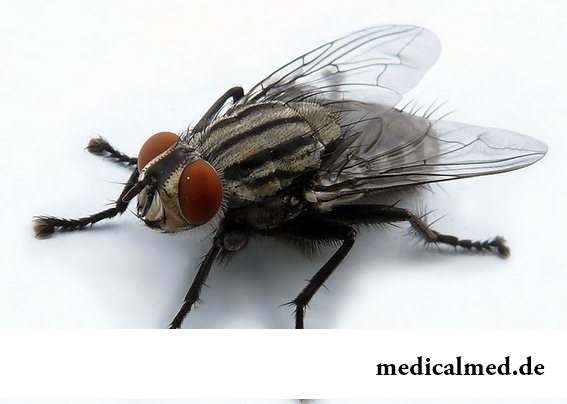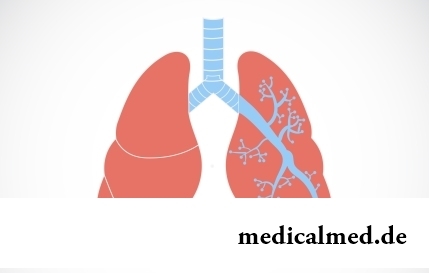





Tsetse-fly disease
General information about an infection

The tsetse-fly disease (African трипасономоз or the African tsetse-fly disease) is an infection about which many readers learned in the childhood, from pages of adventure novels of Jules Verne and Louis Boussenard. The famous authors colourfully described symptoms of a tsetse-fly disease and its awful effects that, however, it is impossible to call exaggeration in any way, in most cases infected really perished. The causative agent of a sleeping sickness gets into a human body after stings of tsetse flies (sort Glossina) who, in turn get sick from animals and people, being carriers of pathogenic parasites from the sort Trypanosoma. The tsetse-fly disease is widespread on the African continent. Every year the tsetse-fly disease is diagnosed for 50-70 thousand people, but the quantity infected constantly decreases that is connected with an urbanization and improvement of quality of life in developing countries.
Specialists allocate several types of the African tsetse-fly disease. The Gambian African tsetse-fly disease is widespread about large lakes and along the rivers. The Rhodesian form, on the contrary, is typical for savannas and often meets in places of cutting down of rainforests. Causative agents of a sleeping sickness – the flat parasites having the oblong and spindle-shaped form. They very small (12-20 microns in length), but mobile, easily move from place to place by means of the translucent membrane going along a body.
Symptoms of a tsetse-fly disease and clinical picture of a disease
The tsetse fly inoculates parasites in hypodermic space during a krovososaniye. A quantity of trypanosomes gets to a blood stream at once, but their most part remains in the place of a sting where there is an active reproduction of contagiums and formation of a characteristic painful node – a chancre. Then parasites begin to extend on a body through interfabric space and absorbent vessels. Interesting what the tsetse-fly disease constantly mutates. The first wave triponasy perishes because of action of antibodies, but during this invisible fight the new, antigenic form of an infection is developed. At the same time one strain of a tsetse-fly disease forms several hundred new options of parasites. No wonder therefore that in the absence of adequate treatment of people it is absolutely defenseless before the African tsetse-fly disease. Causes concern and that fact that specialists still have no idea of that, how exactly there is a defeat of fabrics.
As for symptoms of a tsetse-fly disease. The Rhodesian tsetse-fly disease proceeds more sharply and hard, than Gambian, but, in general, infection signs at both forms – are almost identical:
- existence of an entrance chancre – a painful node in the place of inoculation of trypanosomes. It appears 5-7 days later after the causative agent of a sleeping sickness gets to an organism. The chancre can appear on any body part. Sometimes it is expressed, but finally almost always spontaneously heals;
- remitiruyushchy fever;
- sleeplessness;
- the most severe headaches;
- problems with concentration of attention;
- the developing tachycardia;
- rise in body temperature;
- increase in nodes in a back cervical triangle;
- painful hypodermic hypostases;
- at Europeans in addition to the main symptoms the ring-shaped erythema is shown.
If at the person the African tsetse-fly disease of Gambian type is revealed, exacerbations of a disease are replaced by tranquility stages of latency. At the same time the infection can remain long time not distinguished up to that time until signs of damage of the central nervous system at full capacity are shown. The Rhodesian tsetse-fly disease which symptoms are expressed stronger comes to light quicker. At this form at patients practically at once there comes exhaustion, however, damages of lymph nodes are less noticeable. Let's notice also that in the absence of treatment patients usually perish from intercurrent infections and myocarditis still before the typical syndrome of a tsetse-fly disease develops.
In process of development of an infection, symptoms of a tsetse-fly disease are shown more and stronger. At patients appears absent expression, the under lip droops, eyelids fall. Patients as if fall into a stupor and the farther, the it is more difficult to induce them to perform the simplest operations. They never refuse food, but also do not ask it, extremely seldom make contact with people around. At the last stages the tsetse-fly disease leads to convulsive attacks, tranzitorny paralyzes, a coma, epilepsy and, at last, inevitable death.
Treatment and prevention of the African tsetse-fly disease

For treatment of a tsetse-fly disease are traditionally used: сурамин, organic compounds of arsenic and pentamidine. Often apply эфлорнитин which it is especially effective at a Gambian form. Specific techniques of treatment depend on extent of defeat цнс, medicines resistance of the activator and the general condition of the patient. Because of high toxicity all above-mentioned means have heavy side effects therefore they need to be used only in clinics under constant observation of specialists.
Prevention of a tsetse-fly disease consists in implementation of simple, but efficient rules:
- to refuse visit of focuses of the disease without need, extreme on that;
- to wear light clothes, shirts with long sleeves;
- at an exit to the street to take with itself repellents against insects;
- for the prevention of a disease of times in 6 months to do an intramuscular injection of pentamidine.
People who got used to have breakfast regularly have obesity much less often.

Bulimia and anorexia, are heavy deviations of a feeding behavior, become a cause of death of patients much more often than all others...
Section: Articles about health
The pancreas performs two functions in a human body: release of enzymes without which digestion of carbohydrates, fats and proteins, and a producing hormones is impossible. The most important of them - insulin, is the main participant of carbohydrate metabolism, a normal...
Section: Articles about health
The problem of diagnosis was and remains to one of the most important in medicine. From that, the reason of an indisposition of the patient will be how precisely defined, eventually success of treatment depends. In spite of the fact that the majority of the diagnostic methods applied in official clinical practice has very high informational content and reliability, mistakes directed by diagnoses nevertheless are not excluded....
Section: Articles about health
Shops of household appliances offer us the huge choice of various devices for the house. Whether there are among this abundance devices which...
Section: Articles about health
Feeding by a breast - the integral part of ideal motherhood allowing to come into contact with the kid and to create to it healthy immunity since early years. Nevertheless, this important process in life of mother and child can be saddened laktostazy − by a delay of milts...
Section: Articles about health
The sudden heat on all body which is followed by perspiration and a cardiopalmus – the phenomenon familiar to many people. Most often such states called by "inflows" result from nervous or physical overworks and disappear right after rest. However in certain cases similar reaction of an organism can speak about diseases which need treatment. What? About it below....
Section: Articles about health
Contrary to popular belief, the multiple sclerosis (MS) is not connected neither with sclerous changes of walls of vessels, nor about age...
Section: Articles about health
Long time antibiotics were considered as a panacea from all diseases and were appointed even at insignificant symptoms of an infection. Even now not everyone knows in what force of antibiotics how and when they should be accepted. Let's discredit 7 popular myths about such drugs...
Section: Articles about health
Several decades ago the basil (the district khan, реан, Reagan) was considered as a part of the Caucasian or east cuisine, but today it strongly took the place on tables of Russians. Greens of this plant possess a strong, pleasant smell and specific fresh taste because of which it is included almost in all dry mixes of spicy herbs, and also give to meat and fresh fish dishes....
Section: Articles about health
A lot of things depend on a condition of a backbone in a human body, a backbone - not only a support for a body, it also contain...
Section: Articles about health
Radiological methods of a research are applied in medicine more than hundred years, and thanks to them millions of lives were saved. In many cases without X-ray it is impossible to make exact idea of a condition of bodies and fabrics, it is correct to make the diagnosis. Those...
Section: Articles about health
Dark circles (bruises) under eyes – a shortcoming with most of which often fight against the help of cosmetics (proofreaders, saloon procedures and so forth), eliminating only its visibility. However, according to doctors, skin around eyes – the indicator of many disturbances in an organism. To reveal them at early stages, without having disguised bruise, and having addressed its reasons – a task of each person who is regularly finding under with own eyes dark stains. Early detection and elimination of the disease lying in wasps...
Section: Articles about health
Quite large number of people adheres to the principles of vegetarian food. But how to be if in a family of vegetarians is д...
Section: Articles about health
Bees – really unique beings. Practically all products of their life activity are used by the person. Since the most ancient times medicinal properties of honey and other substances received in the course of beekeeping are known. The fact that all these пр is especially significant...
Section: Articles about health
According to World Health Organization, every third inhabitant of Earth has excess weight, and every tenth has obesity. The reason of this phenomenon, according to specialists, roots in one not very comforting fact: most of people consume much more calories, than it is necessary. How it turns out what we overeat? Why it is so difficult to refuse an excess portion tasty or additives? Let's try to find out what factors prevent us to eat food with reasonable moderation....
Section: Articles about health
Stability of a hormonal background is one of the most important conditions of preservation of health of the woman. At the same time endocrine system –...
Section: Articles about health
When overcomes feeling of hunger, and an opportunity to have dinner fully is absent, having a snack − the meals, small on volume, stabilizing sugar level in blood comes to the rescue. The relation of nutritionists to having a snack is more often negative, but only because in кач...
Section: Articles about health
The word "onikhokriptoz" is unfamiliar to most of people, meanwhile quite so physicians call very widespread problem: the growing of edge of a nail into surrounding fabrics causing inflammatory process. Usually the illness affects thumbs of legs, and is followed by reddening, hypostasis, and in the started cases – release of pus. Patients complain of the pain amplifying when walking, problems with the choice of footwear....
Section: Articles about health
The hysteromyoma is diagnosed more than at a third of women 35 years are more senior. This high-quality new growth, which on early a stage...
Section: Articles about health
History of use of an anesthesia during operations contains more than 160 years. Annually in the world hundreds of thousands of surgical interventions during which to patients the substances immersing them in a dream and saving from pain are entered are carried out. Using an anesthesia to these...
Section: Articles about health
Practically each person is familiar with the annoying, pulling, unscrewing pains caused by overcooling of muscles of a back. In certain cases inflammatory process is not limited to discomfort, being followed by emergence of hypostasis, consolidations, temperature increase. At the wrong treatment the acute miositis can lead to a chronic disease or aggravation of other pathologies of a back (vertebral hernia, osteochondrosis) therefore it is important to pay attention to symptoms of an illness in time and to start to...
Section: Articles about health
They say that to ensure health and longevity of people it is obliged. Really, at competent approach to these questions, we will pass...
Section: Articles about health
Maternal milk is the best food for the newborn. It is the unique natural product containing an optimum set of nutrients, and which is best adapted in order that the baby normally developed and it was protected from harmful fa...
Section: Articles about health
Let's begin with the fact that a separate illness which is called "adjournment of salts", just does not exist. In practice this household name of disbolism leading to development of a number of diseases. Pathological process consists that in an organism there is an accumulation of salts of uric acid (as a rule, owing to failure of a water salt metabolism or insufficiently effective work of secretory system)....
Section: Articles about health
Cold is such painful that each sigh becomes a victory, heat "knocks" down, and the ache in joints forces to think only about...
Section: Articles about health
Smack in a mouth can arise in the natural way – as a result of lack of morning hygiene or reception of the corresponding food. However in certain cases its existence is a sign of certain pathologies, and allows to reveal an illness at an early stage. In we depend...
Section: Articles about health
Such trouble as the milkwoman's attack, at least once in life happened almost to each woman. Prevalence of a disease is explained by the fact that the causative agent of an illness belongs to the so-called opportunistic microflora living on mucous membranes of any human body and which is becoming more active only under favorable conditions. If you had curdled allocations from a vagina, the itch and burning in external genitals, or painful feelings disturb at sex...
Section: Articles about health
